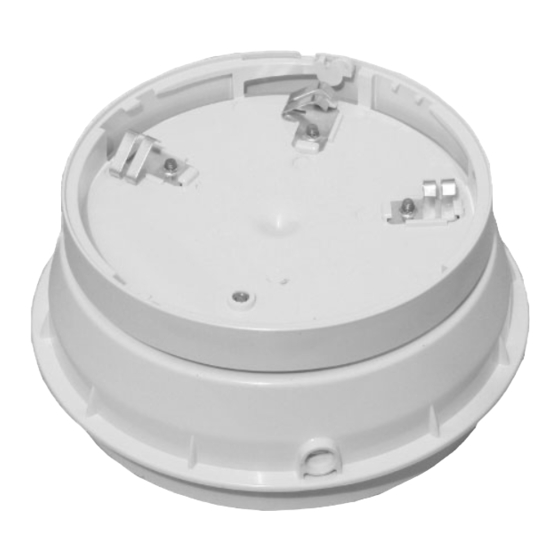
Table of Contents
Advertisement
Quick Links
INSTALLATION INSTRUCTIONS FOR INTEGRATED DETECTOR BASE LOOP
POWERED ADDRESSABLE SOUNDER – SOUNDER STROBE & STROBE
MODELS
MI-BSO-XX-N = Sounder Non Isolation
MI-BSO-XX-I = Sounder Isolation
MI-BSS-XX-N = Sounder Strobe Non Isolation
MI-BSS-XX-I Sounder Strobe Isolation
MI-BST-XX-N = Strobe Non Isolation
MI-BST-XX-I = Strobe Isolation
XX = Colour options available
GENERAL
The range of intelligent devices are designed to be connected to analogue addressable
fire alarm systems.
These devices must only be connected to control panels that use a compatible proprietary
analogue addressable communication protocol.
These devices receive their power from the loop, and can be controlled via the communication
protocol(s).
The Integrated Detector Base Sounder is designed to accept a Series 200 Advanced detector.
The sounders have three volume levels and 32 tone sets. Models (MI-BSO-XX-I, MI-BSS-XX-I,
MI-BST-XX-I) containing the character 'I' prior to the Customer ID code include in built isolation
providing short circuit protection of the loop.
Up to 159 addresses are available. (Consult the panel instructions to confirm compatibility)
These are selected via the two rotary selector switches. The 'tens' digits go from 0 to 15 and
the 'units' from 0 to 9.
Note: if the control equipment is not capable of taking over 99 module addresses, a
fault condition will be generated for every address over 99.
THIS PRODUCT IS NOT APPROVED TO EN54-23 (VISUAL ALARM DEVICES) AND MUST NOT BE
USED AS A VISUAL ALARM DEVICE OR TO PROVIDE A PRIMARY WARNING NOTIFICATION OF FIRE.
SPECIFICATIONS
Signaling Line Supply Voltage (non isolation)
Signaling Line Supply Voltage (isolation)
Max current consumption (non isolation) (High Volume
Tone 13 @24V)
Max current consumption (isolation) (High Volume Tone
13 @24V)
Max peak power
Sound Output to EN54-3 (High Volume Tone 13 @24V)
Beacon flash rate
Max current consumption @24V (non isolation) MI-BST-
XX-*
Max current consumption @24V (isolation) MI-BST-XX-*
Quiescent Current
Operating temperature range
Relative humidity
Terminal Size
For isolator specification refer to document SP11-2848 available on request.
These model types must not be used as visual alarm devices to provide a primary warning
notification of fire.
MI-BSO-XX-N
MI-BSS-XX-N
MI-BST-XX-N
MI-BSO-XX-I
MI-BSS-XX-I
MI-BST-XX-I
15 to 29VDC (24VDC typical)
15 to 29VDC (24VDC typical)
4.46mA
8.40mA
N/A
4.65mA
8.59mA
N/A
148.8mW
243.4mW
99.12mW
96dB(A) ± 3dB
N/A
N/A
1Hz
1Hz
N/A
N/A
3.94mA
N/A
N/A
4.13mA
450uA
o
-25 to +70
C
up tp 93% (± 3%) - non condensing
2
2.5mm
- maximum
TERMINAL
CONNECTIONS
_
4
1
2
+
3
+
_
VOLUME SETTINGS
Volume setting is selected by SW6
and SW7 of the 8 way DIP switch. The
appropriate tone set is selected by SW1 to
SW5 of the 8 way DIP switch (see table 1)
The 2nd stage tone (related to the 1st stage
tone) is controlled by the fire panel via the
protocol.
SW6 SW7 Volume Setting
OFF
OFF
HIGH
OFF
ON
MEDIUM
ON
OFF
LOW
ON
ON
LOW
BASES/IP RATING
B501AP (IP 21C)
INSTALLATION
Affix B501AP to a
suitably flat ceiling.
Terminate the cable
to the appropriate
terminals. For surface
mount wiring the cable can enter the B501AP
via the break outs provided. Select the
appropriate Tone and Volume settings via the
DIP switch.
Locate the main assembly on to the base by
rotating until it locks into place.
CONTINUITY SPRING
The B501AP
incorporates a
continuity spring
between terminals 2
and 4. This allows the
continuity of the field wiring to be checked
without the need for the device to be present.
Inserting the device will disengage the spring.
Removing the device will close the loop.
ANTI TAMPER LOCK
The B501AP also
includes a tamper
resistant feature that
when activated prevents
removal of the unit
without the use of a
special tool.
This method is
consistent with the
anti tamper feature
across all devices
using this base. This
prevents the device
being turned to
enable its release.
Breakout
Advertisement
Table of Contents

Subscribe to Our Youtube Channel
Summary of Contents for MORLEY-IAS MI-BSS-XX-N
- Page 1 Terminate the cable MI-BSO-XX-I = Sounder Isolation to the appropriate terminals. For surface MI-BSS-XX-N = Sounder Strobe Non Isolation mount wiring the cable can enter the B501AP MI-BSS-XX-I Sounder Strobe Isolation via the break outs provided. Select the MI-BST-XX-N = Strobe Non Isolation...
- Page 2 Table 1 - VERSION 8C DIP setting Nominal Maximum consumption (mA) 2nd Stage DIMENSIONS O=Off/1=On Pattern Frequency (BSO-BSS) (BSO-BSS) (BSO-BSS) Switching Frequency Description Market Standard Tone All DBS Variants SW 1,2,3,4,5 High Medium 0,0,0,0,0 Alternating 525/440 4.19 / 8.13 1.58 / 5.52 0.89 / 4.83 2Hz (100ms/400ms) French Fire Sound AFNOR...

Need help?
Do you have a question about the MI-BSS-XX-N and is the answer not in the manual?
Questions and answers